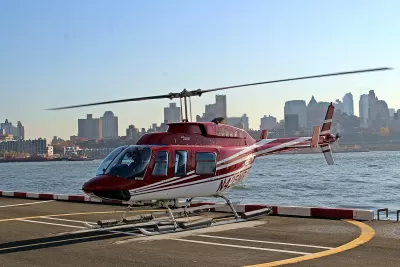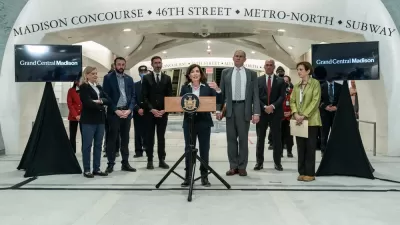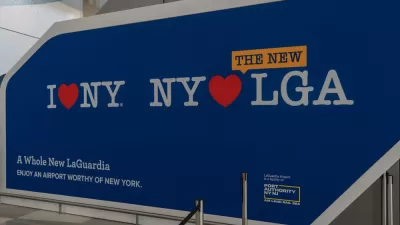Helicopters are an exclusive mode that lets those who can afford it avoid the time and inconveniences of on-the-ground travel. But, say critics, it just highlights the gap between the city's haves and have-nots.

"In New York City, which is saddled with gridlocked roads and slow and unreliable public transit, more and more of those who can afford to are flying over it all," writes James Barron.
The number of private helicopter trips to New York City airports and high-end resort towns on Long Island has increased in recent years, reports Barron. "The jump in helicopter traffic has upset some people on the ground below the flight path who say they have to listen to the incessant roar of the vehicles." Three city council members have also raised safety concerns about helicopters over the city and have called for a Federal Aviation Administration ban on "nonessential" helicopter travel.
Barron also notes that Uber is one of the new contenders in the helicopter travel arena. "The company’s operation in New York is a dress rehearsal for an aerial ride-sharing network elsewhere, using not helicopters but what are essentially air taxis — electric vertical takeoff and landing craft, designed to rise straight up like a helicopter but fly like a fixed-wing aircraft."
FULL STORY: That Noise? It’s the 1%, Helicoptering Over Your Traffic Jam

Trump Administration Could Effectively End Housing Voucher Program
Federal officials are eyeing major cuts to the Section 8 program that helps millions of low-income households pay rent.

Planetizen Federal Action Tracker
A weekly monitor of how Trump’s orders and actions are impacting planners and planning in America.

Ken Jennings Launches Transit Web Series
The Jeopardy champ wants you to ride public transit.

Rebuilding Smarter: How LA County Is Guiding Fire-Ravaged Communities Toward Resilience
Los Angeles County is leading a coordinated effort to help fire-impacted communities rebuild with resilience by providing recovery resources, promoting fire-wise design, and aligning reconstruction with broader sustainability and climate goals.

When Borders Blur: Regional Collaboration in Action
As regional challenges outgrow city boundaries, “When Borders Blur” explores how cross-jurisdictional collaboration can drive smarter, more resilient urban planning, sharing real-world lessons from thriving partnerships across North America.

Philadelphia Is Expanding its Network of Roundabouts
Roundabouts are widely shown to decrease traffic speed, reduce congestion, and improve efficiency.
Urban Design for Planners 1: Software Tools
This six-course series explores essential urban design concepts using open source software and equips planners with the tools they need to participate fully in the urban design process.
Planning for Universal Design
Learn the tools for implementing Universal Design in planning regulations.
Ada County Highway District
Clanton & Associates, Inc.
Jessamine County Fiscal Court
Institute for Housing and Urban Development Studies (IHS)
City of Grandview
Harvard GSD Executive Education
Toledo-Lucas County Plan Commissions
Salt Lake City
NYU Wagner Graduate School of Public Service





























